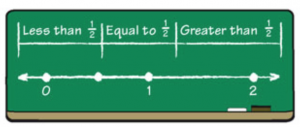Comparing to ½
Purpose
To classify fractions as less than, equal to, or greater than
Materials
Whiteboard
Overview
 Write these three headings and draw this number line on the board. Students will be working with numbers to classify them as less than, equal to, or more than
Write these three headings and draw this number line on the board. Students will be working with numbers to classify them as less than, equal to, or more than ![]() . Place numbers in the appropriate categories on the chart. Students can also show each fraction’s location on the number line.
. Place numbers in the appropriate categories on the chart. Students can also show each fraction’s location on the number line.
About the sequence
Part 1 asks students to think of a fraction and quickly categorize whether this fraction is less than ![]() , equal to
, equal to ![]() or greater than
or greater than ![]() . Part 2 asks students to place more fractions into categories and also determine whether these fractions are closer to 0, 1 or 2 on a mental number line.
. Part 2 asks students to place more fractions into categories and also determine whether these fractions are closer to 0, 1 or 2 on a mental number line.
Part 1
(Create 3 quick and separate sections in your room representing the 3 categories—less than, equal to, or greater than ![]() ).
).
Everyone think of a fraction that is either less than ![]() , equal to
, equal to ![]() or greater than
or greater than ![]() . When I say, GO, move the section of the room where your fraction belongs.
. When I say, GO, move the section of the room where your fraction belongs.
(After everyone’s settled, call out the first category (less than ![]() ) and have a few students share their secret fraction and how it relates to
) and have a few students share their secret fraction and how it relates to ![]() . Record some of their examples on the board in the appropriate section of the chart. Do the same with the other categories. Afterward, ask students to make generalizations about the fractions in each list. You might hear that fractions equal to
. Record some of their examples on the board in the appropriate section of the chart. Do the same with the other categories. Afterward, ask students to make generalizations about the fractions in each list. You might hear that fractions equal to ![]() have a denominator that is twice the numerator (or, a numerator that is
have a denominator that is twice the numerator (or, a numerator that is ![]() the denominator), fractions less than
the denominator), fractions less than ![]() have a numerator that is less than
have a numerator that is less than ![]() the denominator, and fractions greater than
the denominator, and fractions greater than ![]() have a numerator that is greater than
have a numerator that is greater than ![]() the denominator.)
the denominator.)
While children are enjoying their building of mastery, feel free to repeat. When children are eager for more, try Part 2.
Part 2
Now, let’s keep going but we’ll add another step. First, we’ll determine if a fraction is greater than, less than, or equal to ![]() but then we’ll also figure out if this fraction is closer to 0, 1, or 2 on a mental number line.
but then we’ll also figure out if this fraction is closer to 0, 1, or 2 on a mental number line.
(Call out numbers, or write them silently on the board, and ask students to classify them; place in appropriate sections of the chart. Invite students to the board to place fractions on the number line; erase the point after each student).
Examples:
 (greater than
(greater than  , closer to 1 on number line that spans 0, 1, 2)
, closer to 1 on number line that spans 0, 1, 2) (greater than
(greater than  , directly on 2 on number line that spans 0, 1, 2)
, directly on 2 on number line that spans 0, 1, 2) (less than
(less than  , close to 0 on number line that spans 0, 1, 2)
, close to 0 on number line that spans 0, 1, 2) (less than
(less than  , closer to ½ on number line that spans 0, 1, 2)
, closer to ½ on number line that spans 0, 1, 2) (equal to
(equal to  , directly in between 0 and 1 on number line that spans 0, 1, 2)
, directly in between 0 and 1 on number line that spans 0, 1, 2) (equal to
(equal to  so directly halfway between 0 and 1 on number line)
so directly halfway between 0 and 1 on number line) (greater than
(greater than  but exactly equal to 2 on number line)
but exactly equal to 2 on number line) less than
less than  so closer to 0 on number line)
so closer to 0 on number line)- .25 (less than
 so closer to 0 on number line)
so closer to 0 on number line)

This work is licensed under a
Creative Commons Attribution-NonCommercial-NoDerivatives 4.0 International License.
